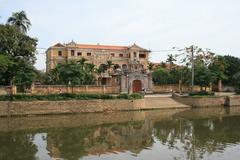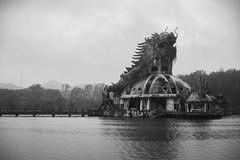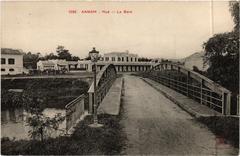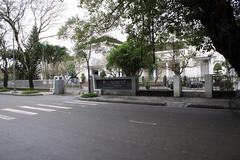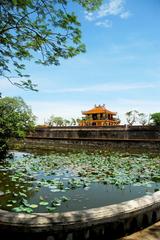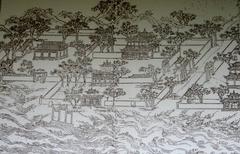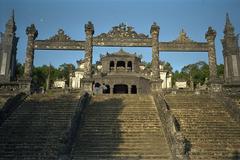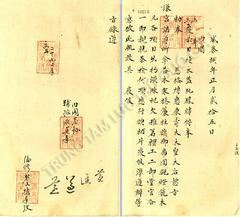
Trang Tien Bridge Visiting Hours, Tickets, and Comprehensive Travel Guide in Hue, Vietnam
Date: 04/07/2025
Introduction: The Enduring Symbol of Hue
Trang Tien Bridge (Cầu Trường Tiền), one of Hue’s most celebrated landmarks, elegantly spans the Perfume River, connecting the old imperial city to its modern districts. Conceived by French engineer Gustave Eiffel at the turn of the 20th century, the bridge stands as a remarkable blend of Vietnamese heritage and colonial engineering. Over more than a century, Trang Tien Bridge has withstood storms, war, and social change, remaining a vital thoroughfare and a symbol of Hue’s resilience and enduring spirit.
This guide provides a detailed look at the bridge’s history, architecture, cultural significance, and practical visitor information—including visiting hours, ticketing, accessibility, travel tips, and nearby attractions. Whether you’re a history buff, photographer, or casual traveler, this article will help you make the most of your visit to this iconic Hue historical site. For further details, refer to resources such as Vietnam Life, Lux Travel DMC, and the Hue Tourism Official Website.
Origins and Construction
Trang Tien Bridge was commissioned by the French colonial government as part of efforts to modernize Hue, the imperial capital of Vietnam. Construction began in 1897 and was completed in 1899. The bridge’s design was entrusted to Gustave Eiffel, whose expertise ensured that the bridge would become both a technical and aesthetic marvel (Vietnam Life).
Originally, the bridge measured 403 meters in length and 6 meters in width, featuring six distinctive steel arches supported by reinforced concrete pillars. The construction, which required thousands of manual rivets, was a significant engineering feat for its time and was primarily intended for pedestrians, horse-drawn carriages, and limited vehicular traffic (Vietnam Life).
Architectural Evolution and Restoration
Early Modifications and Resilience
- 1904 Storm: Only five years after its inauguration, Trang Tien Bridge was severely damaged by a major storm. It was extensively rebuilt and reopened in 1906, a testament to its resilience (Vietnam Life).
- 1937 Expansion: Growing traffic led to the addition of pedestrian walkways on both sides, making it safer and more accessible for the increasing number of pedestrians and cyclists.
Wartime Destruction and Rebuilding
- First Indochina War (1946): Two spans of the bridge were deliberately destroyed by the Viet Minh to disrupt French military operations. Repairs were completed by 1953.
- Tet Offensive (1968): The bridge suffered extensive damage during the Vietnam War, particularly in the Battle of Hue. It remained partially destroyed until postwar reconstruction in 1975 (Vietnam Life).
Modern Enhancements
- 1991–1995 Restoration: The bridge was further reinforced and modernized, including updates to pedestrian pathways and a change in paint color.
- 2002 Lighting System: As part of the Hue Festival, a programmable LED lighting system was installed, transforming the bridge into a luminous nighttime landmark (VinWonders).
Architectural Features and Design
Trang Tien Bridge is characterized by six comb-shaped steel arches, each about 67 meters long, with a total length of 403 meters and a width of 6 meters. The bridge’s elegant silhouette, Gothic-inspired arches, and rhythmic geometry give it a distinctive and harmonious appearance over the Perfume River (Lux Travel DMC).
Decorative elements, such as balustrades and arches, have evolved over time, but the bridge’s core design remains intact. The night-time illumination adds to its aesthetic appeal and has become a highlight for both locals and visitors.
Cultural Significance
Trang Tien Bridge holds a special place in the hearts of Hue’s residents. Its arches are a recurring motif in local art, poetry, and music, evoking nostalgia and pride. The bridge’s proximity to the old coin-casting mint (which inspired the name “Trang Tien”) and its resilience through war and disaster have made it a metaphor for Hue’s enduring spirit (Culture Pham Travel).
The bridge is also a vibrant community space: a route for daily commuters, a gathering place during festivals, and a backdrop for night markets and street performances. Its illuminated arches during the biennial Hue Festival are a symbol of the city’s creativity and communal joy (Origin Vietnam).
Visiting Hours, Tickets, and Accessibility
Visiting Hours
Trang Tien Bridge is open to the public 24 hours a day, making it an ideal spot for early morning walks, daytime sightseeing, or evening strolls under the lights.
Ticket Information
There is no entrance fee. Visitors can walk, cycle, or drive across the bridge at any time, as it is a freely accessible public thoroughfare (VinWonders).
Accessibility
The bridge features pedestrian walkways and gentle ramps at both ends, making it accessible for people of all ages and most mobility levels. Some areas may be crowded during peak hours or festivals, so visitors with mobility challenges should plan accordingly (Vietdan Travel).
How to Get There
Located in the center of Hue, Trang Tien Bridge is within walking distance of major sites like the Imperial City and Dong Ba Market. Taxis, cyclos, and motorbikes are readily available, and several bus routes pass nearby (Asia King Travel).
Nearby Attractions and Activities
- Imperial City (The Citadel): UNESCO World Heritage site, just north of the bridge.
- Dong Ba Market: The city’s largest traditional market, perfect for shopping and street food.
- Thien Mu Pagoda: A historic pagoda accessible by boat or taxi.
- Nguyen Dinh Chieu Walking Street: Vibrant pedestrian area with a night market, street food, and live performances (Vietdan Travel).
Nighttime Ambiance and Events
After dark, Trang Tien Bridge becomes a luminous spectacle, with its arches bathed in colorful LED lights that reflect on the river. The area transforms into a lively social hub, with riverside cafes, street food vendors, and open-air performances, especially during festivals like the Hue Festival (Go Vietnam Tours).
Travel Tips
- Best time to visit: Early morning or sunset for beautiful light and fewer crowds.
- Photography: The bridge, river reflections, and surrounding colonial buildings offer excellent photo opportunities at all times of day.
- Weather: Bring an umbrella during the rainy season (September–December) and sun protection during hot months.
- Local etiquette: Be mindful of crowds and respectful when photographing people.
Frequently Asked Questions (FAQ)
Q: What are the Trang Tien Bridge visiting hours?
A: The bridge is open 24/7.
Q: Is there an entrance fee?
A: No, visiting the bridge is free for everyone.
Q: How do I get to Trang Tien Bridge?
A: The bridge is centrally located and accessible by foot, taxi, motorbike, and public transport.
Q: Is the bridge accessible for people with disabilities?
A: The bridge features ramps and walkways, but it may be crowded during peak times.
Q: Are there guided tours?
A: Many city tours include Trang Tien Bridge as a highlight.
Conclusion and Final Tips
Trang Tien Bridge is more than a feat of engineering—it is a living monument to Hue’s historical journey, connecting the city’s imperial past with its vibrant present. Its free, 24-hour accessibility, central location, and proximity to major attractions make it a must-see for any visitor to Hue.
For further insights and the latest updates, refer to official sources such as Vietnam Life, Lux Travel DMC, and the Hue Tourism Official Website.
Sources and Further Reading
- Vietnam Life’s guide to Truong Tien Bridge
- Trang Tien Bridge Hue: Architectural Highlights – Lux Travel DMC
- Origin Vietnam: Truong Tien Bridge
- VinWonders: Trang Tien Bridge Guide
- Hue Tourism Official Website
- Asia King Travel: Trang Tien Bridge
- Vietdan Travel: Trang Tien Bridge
- Go Vietnam Tours: Trang Tien Bridge
- Culture Pham Travel: Truong Tien Bridge
- IDC Travel: Truong Tien Bridge






